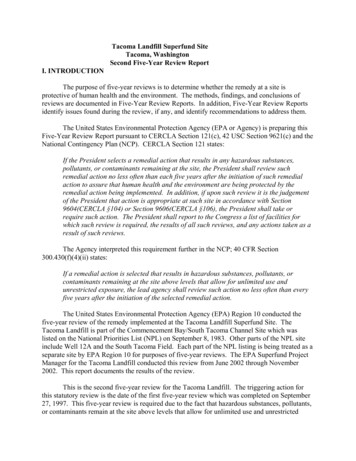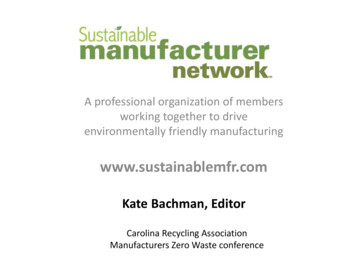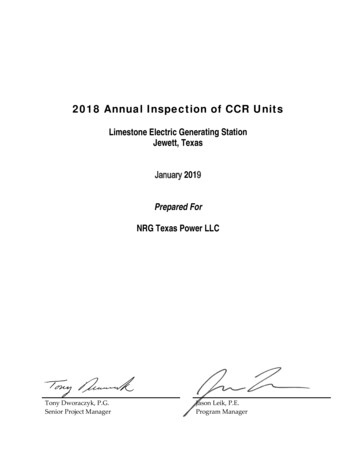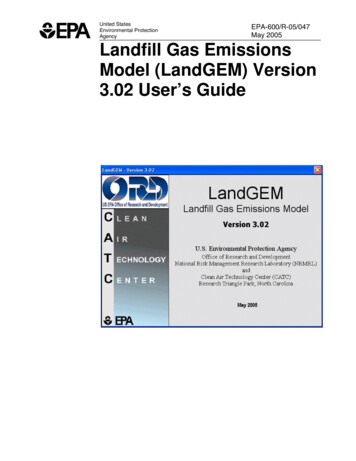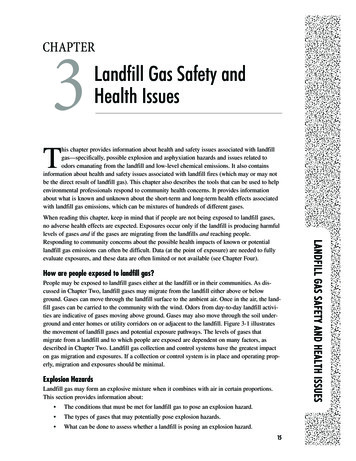
Transcription
CHAPTER3Landfill Gas Safety andHealth Issueshis chapter provides information about health and safety issues associated with landfillgas—specifically, possible explosion and asphyxiation hazards and issues related toodors emanating from the landfill and low-level chemical emissions. It also containsinformation about health and safety issues associated with landfill fires (which may or may notbe the direct result of landfill gas). This chapter also describes the tools that can be used to helpenvironmental professionals respond to community health concerns. It provides informationabout what is known and unknown about the short-term and long-term health effects associatedwith landfill gas emissions, which can be mixtures of hundreds of different gases.THow are people exposed to landfill gas?People may be exposed to landfill gases either at the landfill or in their communities. As discussed in Chapter Two, landfill gases may migrate from the landfill either above or belowground. Gases can move through the landfill surface to the ambient air. Once in the air, the landfill gases can be carried to the community with the wind. Odors from day-to-day landfill activities are indicative of gases moving above ground. Gases may also move through the soil underground and enter homes or utility corridors on or adjacent to the landfill. Figure 3-1 illustratesthe movement of landfill gases and potential exposure pathways. The levels of gases thatmigrate from a landfill and to which people are exposed are dependent on many factors, asdescribed in Chapter Two. Landfill gas collection and control systems have the greatest impacton gas migration and exposures. If a collection or control system is in place and operating properly, migration and exposures should be minimal.Explosion HazardsLandfill gas may form an explosive mixture when it combines with air in certain proportions.This section provides information about: The conditions that must be met for landfill gas to pose an explosion hazard. The types of gases that may potentially pose explosion hazards. What can be done to assess whether a landfill is posing an explosion hazard.15LANDFILL GAS SAFETY AND HEALTH ISSUESWhen reading this chapter, keep in mind that if people are not being exposed to landfill gases,no adverse health effects are expected. Exposures occur only if the landfill is producing harmfullevels of gases and if the gases are migrating from the landfills and reaching people.Responding to community concerns about the possible health impacts of known or potentiallandfill gas emissions can often be difficult. Data (at the point of exposure) are needed to fullyevaluate exposures, and these data are often limited or not available (see Chapter Four).
Figure 3-1: Potential Exposure Pathways to Landfill GasWhen does landfill gas pose an explosion hazard?The following conditions must be met for landfill gas to pose an explosion hazard: Gas production. A landfill must be producing gas, and this gas must contain chemicalsthat are present at explosive levels. Gas migration. The gas must be able to migrate from the landfill. Underground pipes ornatural subsurface geology may provide migration pathways for landfill gas (seeChapter Two, “What factors affect landfill gas migration?”). Gas collection and treatment systems, if operating properly, reduce the amount of gas that is able to escapefrom the landfill. (See Chapter Five.) Gas collection in a confined space. The gas must collect in a confined space to a concentration at which it could potentially explode. A confined space might be a manhole,a subsurface space, a utility room in a home, or a basement. The concentration at whicha gas has the potentialto explode is definedin terms of its lowerLower and Upper Explosive Limits (LEL and UEL)and upper explosiveThe concentration level at which gas has the potential to explode is calledlimits (LEL andthe explosive limit. The potential for a gas to explode is determined by itsUEL), as defined atlower explosive limit (LEL) and upper explosive limit (UEL). The LEL and UELright.are measures of the percent of a gas in the air by volume. At concentrationsbelow its LEL and above its UEL, a gas is not explosive. However, an explosion hazard may exist if a gas is present in the air between the LEL and UELand an ignition source is present.16Chapter 3: Landfill Gas Safety and Health Issues
Landfill Gas ExplosionsAlthough landfill gas explosions are by no means common occurrences, a number of incidentsknown or suspected to have been caused by landfill gas explosions have been documented.An 8-year-old girl was burned on her arms and legs when playing in an Atlanta playground. The areawas reportedly used as an illegal dumping ground many years ago. (Atlanta Journal-Constitution 1999)1994While playing soccer in a park built over an old landfill in Charlotte, North Carolina, a woman wasseriously burned by a methane explosion. (Charlotte Observer 1994)1987Off-site gas migration is suspected to have caused a house to explode in Pittsburgh, Pennsylvania.(EPA 1991)1984Landfill gas migrated to and destroyed one house near a landfill in Akron, Ohio. Ten houses weretemporarily evacuated. (EPA 1991)1983An explosion destroyed a residence across the street from a landfill in Cincinnati, Ohio. Minor injurieswere reported. (EPA 1991)1975In Sheridan, Colorado, landfill gas accumulated in a storm drain pipe that ran through a landfill.An explosion occurred when several children playing in the pipe lit a candle, resulting in serious injuryto all the children. (USACE 1984)1969Methane gas migrated from an adjacent landfill into the basement of an armory in Winston-Salem,North Carolina. A lit cigarette caused the gas to explode, killing three men and seriously injuring fiveothers. (USACE 1984)See the box above for a few of many documented situations where all the conditions for explosions were met and explosions actually occurred.What types of gases can pose an explosion hazard? Methane. Methane is the constituent of landfill gas that is likely to pose the greatestexplosion hazard. Methane is explosive between its LEL of 5% by volume and its UELof 15% by volume. Because methane concentrations within the landfill are typically50% (much higher than its UEL), methane is unlikely to explode within the landfillboundaries. As methane migrates and is diluted, however, the methane gas mixture maybe at explosive levels. Also, oxygen is a key component for creating an explosion, butthe biological processes that produce methane require an anaerobic, or oxygen-depleted,environment. At the surface of the landfill, enough oxygen is present to support anexplosion, but the methane gas usually diffuses into the ambient air to concentrationsbelow the 5% LEL. In order to pose an explosion hazard, methane must migrate fromthe landfill and be present between its LEL and UEL. Other landfill gases. Other landfill gas constituents (e.g., ammonia, hydrogen sulfide,and NMOCs) are flammable. However, because they are unlikely to be present at concentrations above their LELs, they rarely pose explosion hazards as individual gases. Forexample, benzene (an NMOC that may be found in landfill gas) is explosive between its17LANDFILL GAS SAFETY AND HEALTH ISSUES1999
LEL of 1.2% and its UEL of 7.8%. However, benzene concentrations in landfill gas arevery unlikely to reach these levels. If benzene were detected in landfill gas at a concentration of 2 ppb (or 0.0000002% of the air by volume), then benzene would have to collect in a closed space at a concentration 6 million times greater than the concentrationfound in the landfill gas to cause an explosion hazard.Table 3-1 summarizes the potential explosion hazards posed by the important constituents oflandfill gas. Keep in mind that methane is the most likely landfill gas constituent to pose anexplosion hazard. Other flammable landfill gas constituents are unlikely to be present at concentrations high enough to pose an explosion hazard. However, the flammable NMOCs docontribute to total explosive hazard when combined with methane in a confined space.Table 3-1: Potential Explosion Hazards from Common Landfill Gas ComponentsComponentPotential to Pose an Explosion HazardMethaneMethane is highly explosive when mixed with air at a volume between its LEL of5% and its UEL of 15%. At concentrations below 5% and above 15%, methaneis not explosive. At some landfills, methane can be produced at sufficientquantities to collect in the landfill or nearby structures at explosive levels.Carbon dioxideCarbon dioxide is not flammable or explosive.Nitrogen dioxideNitrogen dioxide is not flammable or explosive.OxygenOxygen is not flammable, but is necessary to support explosions.AmmoniaAmmonia is flammable. Its LEL is 15% and its UEL is 28%. However, ammoniais unlikely to collect at a concentration high enough to pose an explosionhazard.NMOCsPotential explosion hazards vary by chemical. For example, the LEL of benzeneis 1.2% and its UEL is 7.8%. However, benzene and other NMOCs alone areunlikely to collect at concentrations high enough to pose explosion hazards.Hydrogen sulfideHydrogen sulfide is flammable. Its LEL is 4% and its UEL is 44%. However, inmost landfills, hydrogen sulfide is unlikely to collect at a concentration highenough to pose an explosion hazard.How can I assess whether a landfill in my community poses an explosion hazard?The checklist on the following page can help determine if a landfill may pose an explosion hazard. If your evaluation identifies the potential for an explosion, several actions can be taken toprevent harm to the community. Measures and controls to prevent explosion hazards are discussed in Chapter Five. Possible public health actions are described in Appendix B.18Chapter 3: Landfill Gas Safety and Health Issues
Landfill Gas Explosion Hazard Checklist Is the landfill producing gas and, if so, how much?Because methane and carbon dioxide are the main components of landfill gas and these chemicals are bothodorless and colorless, monitoring data are necessary to answer this question. (See Chapter Four forinformation about how landfill gas is monitored.) Is a landfill gas collection system in place?Landfill gas collection systems reduce levels of gas migrating from the landfill to surrounding areas.(See Chapter Five for information about collection systems.) Is gas migrating from the landfill?Off-site monitoring data may be necessary to answer this question. (See Chapter Four.) If gas is migrating from the landfill and reaching structures, are there places for gas to collect?Uncontrolled gases escaping from a landfill may migrate to structures on the landfill itself or in thesurrounding area. However, the further a structure is from the landfill, the less likely it is that gases aremigrating to it at concentrations great enough to pose an explosion threat. The most common places forgases to collect are basements, crawl spaces, or buried utility entry ports. Homes with basements,especially those with pipes or cracks in the basement that would allow gas to enter, are more likely tocollect gases. Is gas collecting at concentrations that are high enough to pose an explosion hazard? Is there an ignition source?Gases can be ignited by many different sources, such as a furnace in the basement or a pilot light on a gasstove. Other sources may include candles, matches, cigarettes, or a spark. Because there are so many ignition sources, it is safest to assume that the potential for an ignition source is always present.Asphyxiation HazardsLandfill gas poses an asphyxiation hazard only if it collects in an enclosed space (e.g., a basement or utility corridor) at concentrations high enough to displace existing air and create an oxygen-deficient environment. The Occupational Safety and Health Administration (OSHA) definesan oxygen-deficient environment as one that has less than 19.5% oxygen by volume (OSHAn.d.a). Ambient air contains approximately 21% oxygen by volume. Health effects associatedwith oxygen-deficient environments are described in Table 3-2.Any of the gases that comprise landfill gas can, either individually or in combination, create anasphyxiation hazard if they are present at levels sufficient to create an oxygen-deficient environment.Carbon dioxide, which comprises 40% to 60% of landfill gas, may pose specific asphyxiationhazard concerns. Because it is denser than air, carbon dioxide that has escaped from a landfilland collected in a confined space, such as a basement or an underground utility corridor, mayremain in the area for hours or days after the area has been opened to the air (e.g., after a man-19LANDFILL GAS SAFETY AND HEALTH ISSUESMonitoring data are needed to answer this question. Caution should be used in selecting samplingequipment to ensure that an ignition source is not introduced into the area. (See Chapter Four forinformation about monitoring.)
Table 3-2: Health Effects from Oxygen-deficient EnvironmentsOxygen ConcentrationHealth Effects21%Normal ambient air oxygen concentration17%Deteriorated night vision (not noticeable until a normal oxygen concentration isrestored), increased breathing volume, and accelerated heartbeat14% to 16%Increased breathing volume, accelerated heartbeat, very poor muscularcoordination, rapid fatigue, and intermittent respiration6% to 10%Nausea, vomiting, inability to perform, and unconsciousnessLess than 6%Spasmatic breathing, convulsive movements, and death in minutesSource: OSHA n.d.bhole cover has been removed or a basement door opened). Carbon dioxide is colorless and odorless and therefore not readily detectable. Carbon dioxide concentrations of 10% or more can causeunconsciousness or death. Lower concentrations may cause headache, sweating, rapid breathing,increased heartbeat, shortness of breath, dizziness, mental depression, visual disturbances, orshaking. The seriousness of these symptoms depends on the concentration and duration of exposure. The response to carbon dioxide inhalation varies greatly even in healthy normal individuals.In assessing the public health issues of migrating landfill gas, environmental health professionalsshould investigate the presence of buried utility lines and storm sewers on or adjacent to thelandfill. These structures not only provide a pathway for migrating gases, but also pose a specialasphyxiation problem for utility workers who fail to follow confined space entry procedures prescribed by OSHA. On-site or adjacent residences and commercial buildings with basements orinsulated (or sealed) crawl spaces should also be investigated for potential asphyxiation hazards.Health Issues Associated with Landfill Gas EmissionsLandfill odors often prompt complaints from community members. People may also have concerns about health effects associated with these odors and other emissions coming from the landfill. This section contains information about Symptoms possibly triggered by landfill gas odors. What scientists know about the potential health effects of exposures to landfill gas emissions. How environmental health professionals can assess whether landfill gas emissions maybe posing a health threat.Can the presence of odors trigger symptoms?People in communities near landfills are often concerned about odors emitted from landfills. Theysay that these odors are a source of undesirable health effects or symptoms, such as headaches andnausea. At low-level concentrations—typically associated with landfill gas—it is unclear whetherit is the constituent itself or its odors that trigger a response. Typically, these effects fade when theodor can no longer be detected. The box below describes the biology behind detecting odors.20Chapter 3: Landfill Gas Safety and Health Issues
Landfill gas odors are produced by bacterial or chemical processes and can emanate from bothactive or closed landfills. These odors can migrate to the surrounding community. Potentialsources of landfill odors include sulfides, ammonia, and certain NMOCs, if present at concentrations that are high enough. Landfill odors may also be produced by the disposal of certain typesof wastes, such as manures and fermented grains. Sulfides. Hydrogen sulfide, dimethyl sulfide, and mercaptans are the three most common sulfides responsible for landfill odors. These gases produce a very strong rotten-eggsmell—even at very low concentrations. Of these three sulfides, hydrogen sulfide isemitted from landfills at the highest rates and concentrations.Humans are extremely sensitive to hydrogen sulfide odors and can smell such odors atconcentrations as low as 0.5 to 1 part per billion (ppb). At levels approaching 50 ppb,people can find the odor offensive. Average concentrations in ambient air range from0.11 to 0.33 ppb (ATSDR 1999a). According to information collected by theConnecticut Department of Health, the concentration of hydrogen sulfide in ambient airaround a landfill is usually close to 15 ppb (CTDPH 1997; ATSDR 1999a).How Do People Detect Odors?LANDFILL GAS SAFETY AND HEALTH ISSUESHumans can distinguish between 3,000 and 10,000 different odors. Although people commonly believe that theysmell with their noses, the nose is only one part of the olfactory system that allows humans to distinguish smells.The nose serves as a vacuum that pulls in air and odorous chemicals, such as hydrogen sulfide. The air andodorous chemicals are warmed in the nasal cavity and then trapped in mucus surrounding the olfactorymembrane. The olfactory membrane is an area smaller than 1 square inch located deep in the nasal cavitybetween the eyes. Odorous chemicals interact with receptors (chemoreceptors) found on small hairs (cilia) on theolfactory membrane. The receptors send messages about the odorous chemicals to the brain through theolfactory bulb. The brain then interprets and identifies the odor (Jacobs 1999).The sense of smell, just like the other senses of sight, hearing, taste, and touch, varies from person to person.One person may be able to smell an odor like hydrogen sulfide at extremely low concentrations, while anotherperson in the same community or home cannot. Because of this variation, there is no true odor threshold valueabove which odors are unpleasant and below which odors are not noticeable. Any odor threshold values reportedin the literature, such as those provided in Table 3-3, are only estimates of concentrations that the average personmay detect (AIHA 1989). Therefore, health professionals should be cautious when citing established thresholdvalues or discussing them with community members.Anatomy of Smell21
Ammonia. Ammonia is another odorous landfill gas that is produced by the decomposition of organic matter in the landfill. Ammonia is common in the environment and animportant compound for maintaining plant and animal life. People are exposed daily tolow levels of ammonia in the environment from the natural breakdown of manure anddead plants and animals. Because ammonia is commonly used as a household cleaner,most people are familiar with its distinct smell.Humans are much less sensitive to the odor of ammonia than they are to sulfide odors.The odor threshold for ammonia is between 28,000 and 50,000 ppb. Landfill gas has beenreported to contain between 1,000,000 and 10,000,000 ppb of ammonia, or 0.1% to 1%ammonia by volume (Zero Waste America n.d.). Concentrations in ambient air at or nearthe landfill site are expected to be much lower. NMOCs. Some NMOCs, such as vinyl chloride and hydrocarbons, may also cause odors.In general, however, NMOCs are emitted at very low (trace) concentrations and areunlikely to pose a severe odor problem.Table 3-3 lists some of the common landfill gas components and their odor thresholds.Many people may find the odors emitted from a landfill offensive or unpleasant. In reaction to theodor, some people may experience nausea or headaches. Although such responses are undesirable,medical attention is usually not required. Often, symptoms such as headaches and nausea fadewhen the odor goes away. However, the effects on day-to-day life can be more lasting. Familiesliving close to a landfill in Connecticut described frequent odor events as overwhelmingly disruptive. One family reported being awakened during predawn hours by a flood of nauseating air thatpersisted for 2 or more hours. The loss of sleep and the frustration from the frequent odor eventsgreatly added to the level of stress in the family’s life. Although landfill odors may not associatedwith long-term adverse health effects or illness for most people, the added disruption and stress ofday-to-day activities can greatly impact quality of life. The story below describes how environmental and health professionals addressed odor problems in Danbury,Connecticut.Table 3-3: Common Landfill Gas Components and Their Odor ThresholdsComponentOdor DescriptionOdor Threshold(parts per billion)Hydrogen SulfideStrong rotten egg smell0.5 to 1AmmoniaPungent acidic or suffocating odor1,000 to 5,000BenzenePaint-thinner-like odor840DichloroethyleneSweet, ether-like, slightly acrid odor85DichloromethaneSweet, chloroform-like odor205,000 to 307,000EthylbenzeneAromatic odor like benzene90 to 600TolueneAromatic odor like benzene10,000 to 15,000TrichloroethyleneSweet, chloroform-like odor21,400TetrachloroethyleneSweet, ether- or chloroform-like odor50,000Vinyl ChlorideFaintly sweet odor10,000 to 20,000Sources: NTP n.d.; NJDHSS n.d.22Chapter 3: Landfill Gas Safety and Health Issues
The impact of landfill gas odors on sensitive populations such as people with pre-existing respiratory illnesses is not well documented or understood. A study conducted on Staten Island showedan increase in self-reported wheezing among asthmatics living near a landfill on days when theyreported odors. Ambient air measurements, however, showed levels of hydrogen sulfide and otheremissions much lower than levels known to be associated with adverse health effects (ATSDR1999b). The box below provides more information about this study. The study suggests that odorsin and of themselves may trigger respiratory effects among asthmatics. This preliminary conclusion may be confounded by other environmental triggers for respiratory response in asthmatics,such as dust mites, animal dander, tobacco smoke, and outdoor air pollution. The American LungAssociation Web site (http://www.lungusa.org/asthma/index.html) provides more informationabout possible environmental triggers for asthma. EPA provides information about asthma itself athttp://www.epa.gov/children/asthma.htm and http://www.epa.gov/iaq/asthma/.The Danbury Landfill—One Community's StoryDanbury, Connecticut, is a community that successfully tackled a landfill odor problem. In the Spring of 1996,a 100-year-old landfill in Danbury caught fire. Water used to extinguish the fire promoted bacteria growth andincreased the production of odor-causing sulfides, especially hydrogen sulfide.The increase in odors prompted public concerns and questions. Though hydrogen sulfide levels in the air werewell below concentrations that might affect human health, the odor caused nausea and headaches in someresidents. Local and state health authorities and environmental agencies worked together to address the odorproblem. They took the following actions to alleviate community concerns and address the odor problem: Local health departments produced and distributed a newsletter to educate community members aboutlandfill odors and what was being done to reduce them. Hydrogen sulfide concentrations were measured with monitoring devices located in areas where exposuremight occur, such as nearby residential homes and retail areas. Concerned parties developed a four-tieredresponse plan based on measured hydrogen sulfide concentrations in the nearby community:1. At concentrations greater than 100 ppb for 15 minutes, landfill operators would take immediate action toreduce emissions.2. At concentrations greater than 100 ppb for 2 hours, medical personnel would be notified that sensitiveindividuals (e.g., children, elderly, or asthmatics) might be affected.3. At concentrations greater than 500 ppb for 2 hours, sensitive individuals would be advised to stay indoorsor leave the area.4. At concentrations greater than 5,000 ppb for 30 minutes, all residents would be advised to leave the area.The first action level was triggered a few times during the period when odor control measures were being installed.The other action levels were never triggered. Once odors were controlled, community complaints decreasedmarkedly.23LANDFILL GAS SAFETY AND HEALTH ISSUES Landfill operators controlled sulfide releases and odors by adding lime as a short-term solution and byinstalling a fabric landfill liner, a gas collection system, and a flaring system as the long-term solution.
What do we know about the potential health effects of exposure to landfill gas?Landfill gas constituents are typically found in ambient air at low concentrations unlikely to causeadverse health effects. However, whether landfill emissions pose a health hazard depends on thechemical concentrations to which people are being exposed and the duration of the exposure.Fresh Kills Landfill—A Case StudyATSDR conducted a health study of communities near the Fresh Kills Municipal Landfill in Staten Island, NewYork. The study was undertaken to gain a better understanding of the possible health risks posed by the landfillto residents in nearby communities. ATSDR designed the study to assess how hydrogen sulfide concentrations,odors, and proximity of residence to the landfill might affect respiratory function. The focus was on asthma.A group of more than 150 community residents reported as having asthma volunteered to participate in the study.For a 6-week period in July through September 1997, when annual landfill emissions tend to be at their peak,study participants completed a daily diary to record perceived odors, respiratory symptoms, and daily activities.Participants also measured their lung function each morning and evening with a peak expiratory flow meter.During this same period, ATSDR conducted continuous monitoring in the study area to assess ambient airconcentrations of hydrogen sulfide, ozone, and particulate matter. Meteorologic data as well as pollen and fungicounts were collected; these are confounding factors that can trigger asthma. ATSDR also conducted a separateodor impact survey to provide an independent odor assessment around the landfill.ATSDR concluded that the measured levels of hydrogen sulfide and other parameters were not high enoughto cause adverse health effects. However, when study participants reported that they smelled rotten eggs orgarbage, they also reported that they were more likely to wheeze or experience difficulties in breathing. Amoderate decline in lung function was also documented on days when participants reported these odors. Theseresults varied throughout the study group by factors such as the participant's age and how long he or she hadsuffered from asthma (ATSDR 1999b).In addition to concerns about persistent landfill gas odors, people living near a landfill may beconcerned about the health effects of exposures to the landfill gas mixture or specific landfill gasconstituents, both in the short term and in the long term. As described below, odor-producingchemicals (i.e., hydrogen sulfide and ammonia) are not likely to produce long-term adverse healtheffects at the levels typically associated with landfill emissions. The odors associated with thesechemicals can, however, cause acute (short-term) effects, such as nausea and headaches, as mentioned earlier. Acute effects from other chemicals found in landfill gas are usually produced onlywhen an individual is exposed at relatively high concentrations (i.e., at concentrations greater thanthose expected to be present in ambient air near a landfill). Acute effects are usually reversedwhen the odor or exposure ends. 24Hydrogen sulfide. To date, researchers have not identified any long-term health effectsassociated with exposure to the low-level hydrogen sulfide concentrations that normallyoccur in communities near landfills. As mentioned previously, hydrogen sulfide concentrations in the air around a landfill are usually less than 15 ppb (CTDPH 1997). See thebox below for more detailed information about the health effects associated with exposures to various concentrations of hydrogen sulfide. Figure 3-2 displays the healtheffects of hydrogen sulfide exposure at increasing concentrations.Chapter 3: Landfill Gas Safety and Health Issues
Ammonia. Studies of health effects resulting from exposure to ammonia have found thatpeople who inhale 50,000 ppb of ammonia in the air for less than 1 day experienceslight and temporary irritation. Irritation, therefore, begins at concentrations at or abovethe odor threshold. People exposed to 500,000 ppb for 30 minutes increase their airintake and report soreness of the nose and throat. Ammonia can be fatal when a personis exposed to 5,000,000 ppb for under 30 minutes. This concentration is equivalent to anatmosphere containing 0.5% ammonia. A study of chronic ammonia exposure found thatpeople exposed to ammonia at a concentration of 100,000 ppb in air for more than 6weeks experienced eye, nose, and throat irritation (ATSDR 1990). Concentrations ofammonia in the ambient air near a landfill are expected to be well below the levels atwhich any adverse health effects are expected to occur. NMOCs. The health effects of other landfill gas constituents, such as NMOCs, need tobe considered on a chemical-by-chemical basis. It is also important to consider theirWhat Do Scientists Know About the Health Effectsof Hydrogen Sulfide?Researchers have studied both animal and human subjects (including asthma sufferers) to learn about possiblehealth effects resulting from exposure to varying concentrations of hydrogen
Asphyxiation Hazards Landfill gas poses an asphyxiation hazard only if it collects in an enclosed space (e.g., a base-ment or utility corridor) at concentrations high enough to displace existing air and create an oxy-
